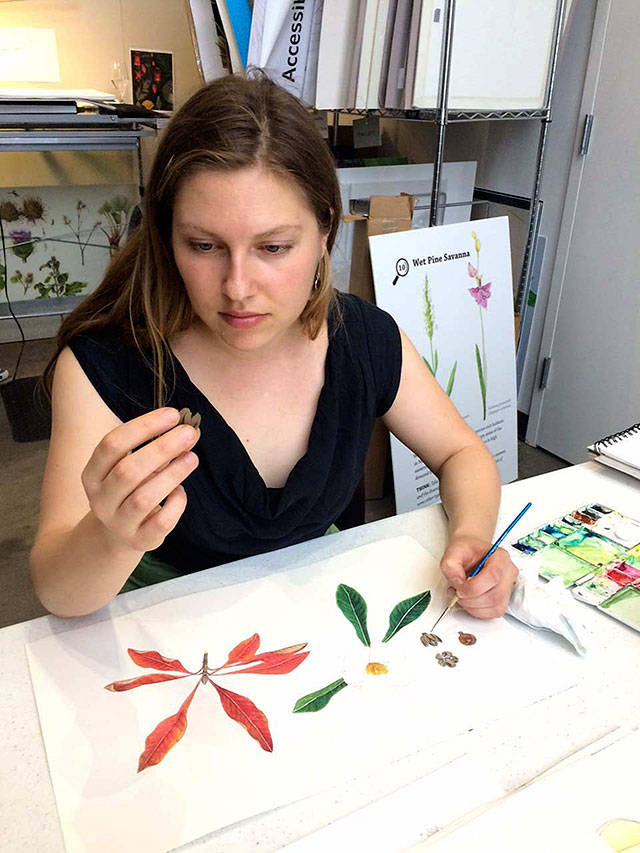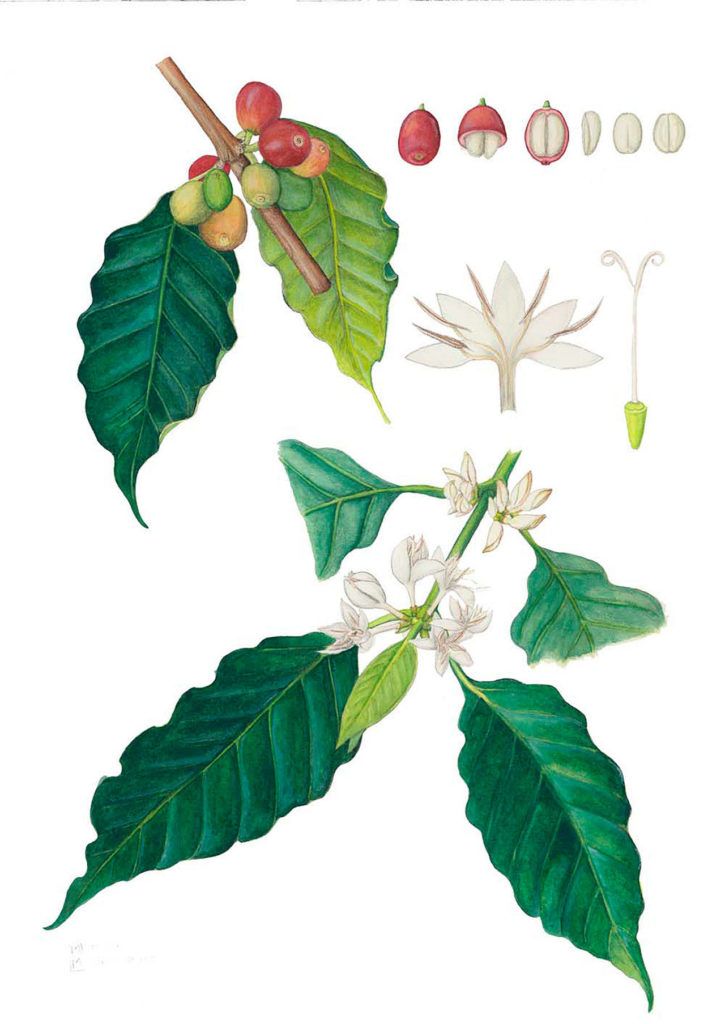By Adrian Higgins, The Washington Post
At 24, Mara Menahan has noticed something that most people miss their entire lives: That bar of chocolate, the pomegranate on your salad, the cup of coffee — all these familiar victuals begin life as a flower.
Or as vastly different and complex flowers.
Menahan has signed off as the U.S. Botanic Garden’s first in-house botanical illustrator in modern times, arriving as a Truman Scholar. Her year-and-a-half stint brought her into close contact with an extraordinary range of plants and blooms, from the tropical flora in the ornate conservatory at the foot of the Capitol to the adjoining outdoor gardens of hardy plants.
“Looking back, what I have done here is to illustrate floral diversity,” she said. If she once thought the generic flower was a daisy, her time at the Botanic Garden has wholly altered that view. There is no archetypal bloom.
She has painstakingly reproduced leaves, seeds, flowers, stems and other plant pieces, assembling them into more than 200 plates. She worked by converting sketchbook images into watercolor renderings at an artist’s table in a private gallery within the conservatory.
If you want an example, she said, of the gap between a fruit and its blossom, you need look no further than the ubiquitous banana. Menahan leads me to the conservatory’s displays of wild banana plants to explain their weird floral architecture.
From a single, pendent stalk, pollinated female flowers are forming the familiar bunches of bananas, but they’re small and green. At the end of the stalk, a purple, grenade-shaped inflorescence houses hidden male flowers. At night, it lifts one of its plates to reveal clusters of pollen-bearing flowers. This is for the benefit of a passing bat, which the banana uses as a pollinator.
There are no bats in the conservatory, and commercial bananas are propagated by cloning, not seed production, but the point is clear — the banana is among plant species that have developed astonishingly intricate ways of reproducing and luring pollinators.
Menahan moves to a more central display bed in the Garden Court to look at another bizarre economic plant doing its thing. The conservatory’s somewhat celebrated cacao tree is festooned with the large, golden-yellow seedpods containing the beans that give us chocolate.
The oddest aspect of its reproductive life is that the blossoms emerge directly from the bark of the trunk, much like the flowers of the common redbud tree. So the cacao’s football-shaped seedpods ripen right on the trunk as well.
She is struck by how large a seedpod grows from so small a blossom. She used a microscope to discern its parts before rendering it magnified several times. “I think it’s amazing that every chocolate bar begins with a flower, not just any flower but a tiny flower the size of my pinkie fingernail,” she said.
Her finished plate also shows the cross section of the ripened fruit, the goopy white covering over the beans and the naked seed, which, as it turns out, is purple. With only the odd accidental pollinator in the conservatory, the flowers are hand-pollinated by the Botanic Garden’s arborist, and the journey from bloom to fruit takes several months.
This progression of life-cycle stages, in turn, kept her juggling her subjects. “Often, I would have to stop what I’m doing to sketch something that’s ephemeral,” she said. That might be the swelling of a young pomegranate fruit or the fall coloring of a franklinia leaf.
“I approached all of these with questioning,” she said. “What’s the purpose of this [part]? What happens afterward?”
Her favorite painting is of an array of seeds that, like the coconut, are designed to be transported across bodies of water for dispersal. She captured 15 species of so-called sea beans.
The most distasteful assignment had to be her rendering of a cross section of a pitcher plant, sliced to reveal the pitcher’s foul digestive juices and the luckless flies within.
“It was really disgusting but shows how the plant eats the flies,” she said.
This was part of a focus on native carnivorous plants. Another beguiling image is of the Venus’s flytrap in flower. The delicate white blossoms are held aloft on long wiry stems, presumably to keep the pollinators from being eaten.
The images already have been incorporated into booklets and signs for visitors (Menahan also worked on an eight-panel mural for the conservatory’s new Mediterranean plant gallery), and the images will form part of the Botanic Garden’s archives.
Menahan is from Montana and is now heading to southern Utah to paint the geology, flora and fauna of the high mesa. Her sojourn east brought her to a lush, green world that D.C.-area residents probably take for granted. Autumn colors were a revelation, the humid summer more of an irritation, but she is struck by the rich confluence of Southern and Northern plants in the mid-Atlantic. This abundance is intensified at the Botanic Garden, whose outdoor gardens on either side of Independence Avenue SW — the National Garden and Bartholdi Park — hold floral riches, native and exotic.
Menahan has been drawing birds since childhood but didn’t decide to become an artist until she was already a student of environmental science at the University of Montana. “I didn’t realize that natural history illustration was a career path,” she said.
She switched majors and studied with other artists. She hopes to earn a master’s degree in fine art and knows that even if her painting career takes her beyond strict botanical illustration, her time at the Botanic Garden and her close examination of so much flora will stay with her. “It’s so grounded in looking that it will be the foundation of whatever artistic pursuits I move into,” she said.
And she’ll never look at chocolate the same way again.
Talk to us
> Give us your news tips.
> Send us a letter to the editor.
> More Herald contact information.


























